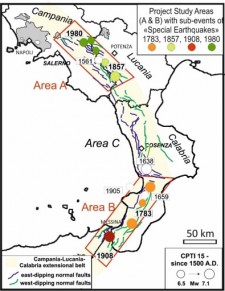PRIN MUSE 4D

Tectonic, dynamic and rheological over time control on destructive MUltiple Seismic Events. Special faults & earthquakes in southern Italy: from real 4D cases to models

MUSE-4D is intended to study tectonic, dynamic and rheological control on seismogenic extensional faulting. We focus on 4 M7-class multi-event Special EarthQuakes (SEQs): Irpinia 1980, Reggio-Messina 1908, Lucania 1857, South Calabria 1783. These events and their host structures are analysed in an innovative overtime (Quaternary and active) and multi-scale (local to regional) perspective with a fully integrated interdisciplinary (geology, seismology, geophysics) approach.
The research is aimed at developing:
- a new unified 3D geometric and kinematic fault model of the southern Campania-Lucania (Area A) and southern Calabria (Area B) seismogenic systems (Product 1), within the seismotectonic context of the southern Apennines of Italy (Product 2);
- a 4D seismotectonic model of the SEQs structural/rheological and seismological complexities and their interconnection in time and 3D space (Product 3), with a special focus on the possible presence of time transitory barriers to the deformation propagation (i.e. Earthquake Gates);
- analogue dynamic models that schematically reproduce the SEQS complexities and highlight fault parameters most influent on surface deformation/rupture patterns;
- an overall new understanding of overtime tectonics and earthquake dynamics in southern Italy.